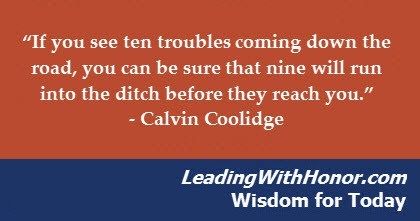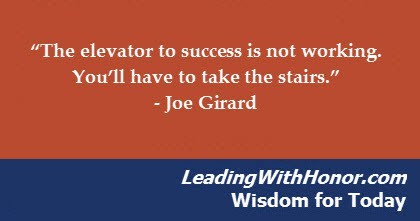Lee Ellis's Blog, page 284
January 25, 2016
Leading with Honor FAQ – “What are some leadership tips for setting and achieving my personal and professional goals?”
Leading with Honor FAQ from Lee Ellis | Please read and share your wisdom and tips in this post, too – thank you
Question:
“What are some leadership tips for setting and achieving my personal and professional goals?”
Answer:
Remember how you have sacrificed in the past and the reward that came from your suffering.
When you have eaten nothing in a Vietnam POW camp but a bowl of thin soup and a piece of bread or cup of rice twice a day for weeks, months, years, you know you can eat almost anything and survive well on a lot less than the typical American diet. What seemed like sacrifice became the accepted way of life because it was the only way to achieve our goals. You also have examples where you’ve paid the price—reflect on them.
Use determination and discipline to overcome your fears.
When you sacrifice (and even suffer) to achieve an important goal, it’s fear that you have to combat. As a writer, I have to fight off the “fear of failure” voices in my head telling me “this is no good” and “who would read this?” We must fight back, knowing that once we kick fear out of the way, we’ll find that sacrifice helps us reach beyond ourselves and find success. Lean into the pain of your doubts and fears and do what’s needed to achieve your worthy goal.
Make your goal public and enlist a support team to encourage you along the way.
The wisdom of the ages is that you should never fight alone. In the POW camps, we would risk our lives to reach out to isolated teammates. Victory is usually a team effort and especially when you’re fighting discouragement. Who will encourage and support you when things get tough, and help you stay the course?
Read the entire article on this topic!


January 24, 2016
On This Day in Leadership History, January 24, 2016
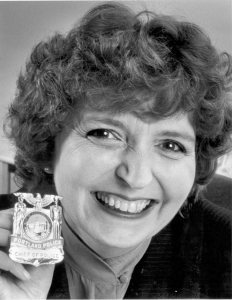 On this day in leadership history in 1985, Penny Harrington became the first woman police chief of a major city, Portland Oregon (940 officers and staff). Harrington began working as a policewoman in 1964, when there were only 12 women in her department.
On this day in leadership history in 1985, Penny Harrington became the first woman police chief of a major city, Portland Oregon (940 officers and staff). Harrington began working as a policewoman in 1964, when there were only 12 women in her department.
What personal and professional challenges do you think that Penny had to overcome to accept this job? One of the limiting emotions for her (and all of us) is fear. What leadership challenge do you have to overcome to keep moving forward? Please share it here –
Penny Harrington – Wikipedia


January 22, 2016
Leading with Honor Wisdom for Today, January 22, 2016
“If you see ten troubles coming down the road, you can be sure that nine will run into the ditch before they reach you.” – Calvin Coolidge


January 21, 2016
Thank You, Autumn, for Your Kind Words!
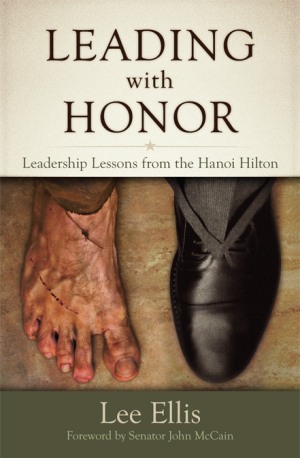 Thanks Autumn F. for your kind endorsement of Leading with Honor –
Thanks Autumn F. for your kind endorsement of Leading with Honor –
“Fantastic book. I bought it after I had taken it out from the library & read through it. I don’t buy too many books as my house isn’t big enough for much of a library, but this one was worth it as I will read it every couple years. The life lessons are applicable to military and non-military alike, and are valuable to read over and over again to instill the leadership practices into one’s everyday life and work ethic. The way that Lee Ellis seamlessly blends the stories from his time as a P.O.W. into leadership lessons makes it a riveting read, along with being applicable across a gamut of life situations. I definitely recommend this book to anyone looking to improve their personal leadership style in the workplace, at home, and in everyday life.”


January 20, 2016
Decoding Leadership: What Really Matters
 by Claudio Feser, Fernanda Mayol, and Ramesh Srinivasan – McKinsey & Company
by Claudio Feser, Fernanda Mayol, and Ramesh Srinivasan – McKinsey & Company
(Editor’s Note: Occasionally, we feature exceptional articles on the topic of natural leadership behavior that we think may be of insight and interest to you. We hope that this article from McKinsey & Company is helpful in your leadership development process.)
Telling CEOs these days that leadership drives performance is a bit like saying that oxygen is necessary to breathe. Over 90 percent of CEOs are already planning to increase investment in leadership development because they see it as the single most important human-capital issue their organizations face.1 And they’re right to do so: earlier McKinsey research has consistently shown that good leadership is a critical part of organizational health, which is an important driver of shareholder returns.2
A big, unresolved issue is what sort of leadership behavior organizations should encourage. Is leadership so contextual that it defies standard definitions or development approaches?3 Should companies now concentrate their efforts on priorities such as role modeling, making decisions quickly, defining visions, and shaping leaders who are good at adapting? Should they stress the virtues of enthusiastic communication? In the absence of any academic or practitioner consensus on the answers, leadership-development programs address an extraordinary range of issues, which may help explain why only 43 percent of CEOs are confident that their training investments will bear fruit.
Our most recent research, however, suggests that a small subset of leadership skills closely correlates with leadership success, particularly among frontline leaders. Using our own practical experience and searching the relevant academic literature, we came up with a comprehensive list of 20 distinct leadership traits. Next, we surveyed 189,000 people in 81 diverse organizations4 around the world to assess how frequently certain kinds of leadership behavior are applied within their organizations. Finally, we divided the sample into organizations whose leadership performance was strong (the top quartile of leadership effectiveness as measured by McKinsey’s Organizational Health Index) and those that were weak (bottom quartile).
What we found was that leaders in organizations with high-quality leadership teams typically displayed 4 of the 20 possible types of behavior; these 4, indeed, explained 89 percent of the variance between strong and weak organizations in terms of leadership effectiveness (exhibit).
Four kinds of behavior account for 89 percent of leadership effectiveness.
– Solving problems effectively. The process that precedes decision making is problem solving, when information is gathered, analyzed, and considered. This is deceptively difficult to get right, yet it is a key input into decision making for major issues (such as M&A) as well as daily ones (such as how to handle a team dispute).
– Operating with a strong results orientation. Leadership is about not only developing and communicating a vision and setting objectives but also following through to achieve results. Leaders with a strong results orientation tend to emphasize the importance of efficiency and productivity and to prioritize the highest-value work.
– Seeking different perspectives. This trait is conspicuous in managers who monitor trends affecting organizations, grasp changes in the environment, encourage employees to contribute ideas that could improve performance, accurately differentiate between important and unimportant issues, and give the appropriate weight to stakeholder concerns. Leaders who do well on this dimension typically base their decisions on sound analysis and avoid the many biases to which decisions are prone.
– Supporting others. Leaders who are supportive understand and sense how other people feel. By showing authenticity and a sincere interest in those around them, they build trust and inspire and help colleagues to overcome challenges. They intervene in group work to promote organizational efficiency, allaying unwarranted fears about external threats and preventing the energy of employees from dissipating into internal conflict.
We’re not saying that the centuries-old debate about what distinguishes great leaders is over or that context is unimportant. Experience shows that different business situations often require different styles of leadership. We do believe, however, that our research points to a kind of core leadership behavior that will be relevant to most companies today, notably on the front line. For organizations investing in the development of their future leaders, prioritizing these four areas is a good place to start.
MC
About the authors
Claudio Feser is a director in McKinsey’s Zürich office, Fernanda Mayol is an associate principal in the Rio de Janeiro office, and Ramesh Srinivasan is a director in the New York office.
The authors wish to thank Michael Bazigos, Nate Boaz, Aaron De Smet, Lili Duan, Chris Gagnon, Bill Schaninger, and Ekaterina Titova for their contributions to this article.
Article Source – Link
Behavioral assessments like Leadership Behavior DNA can easily pinpoint natural strengths and struggles as a foundation for leadership evaluation and development. Click to learn more, and download a free report.
References:
1.The State of Human Capital 2012—False Summit: Why the Human Capital Function Still Has Far to Go(PDF–1,204KB), a joint report from The Conference Board and McKinsey, October 2012.
2.See Aaron De Smet, Bill Schaninger, and Matthew Smith, “The hidden value of organizational health—and how to capture it,” McKinsey Quarterly, April 2014.
3.See Ralph M. Stogdill, “Personal factors associated with leadership: A survey of the literature,” Journal of Psychology: Interdisciplinary and Applied, 1948, Volume 25, Issue 1, pp. 35–71. Also, for more on our work with Egon Zehnder, notably the contrast between organizations growing organically and those growing through acquisition, see Katharina Hermann, Asmus Komm, and Sven Smit, “Do you have the right leaders for your growth strategies?,”McKinsey Quarterly, July 2011.
4.The 81 organizations are diverse in geography (for instance, Asia, Europe, Latin America, and North America), industry (agriculture, consulting, energy, government, insurance, mining, and real estate), and size (from about 7,500 employees to 300,000).


January 19, 2016
Fill-in-the-Blank – “The last time that I made a worthy sacrifice as a leader was ________________________.”
Fill-in-the-Blank – “The last time that I made a worthy sacrifice as a leader was ________________________.”
Please share your answers and comments in the this post – thank you


January 18, 2016
New Lee Ellis Interview from the US Dept of Public Affairs
In this new interview clip from the US Dept of Public Affairs, Lee shares his personal thoughts on crisis leadership and the lessons that he learned from his senior leaders as a young 20-something lieutenant. Please watch and share with others –
Veterans in Blue Series – Link


January 17, 2016
On This Day in Leadership History, January 10, 2016
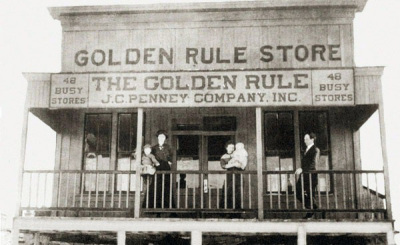 On this day in leadership history in 1913, all partner interests in 36 Golden Rule Stores were consolidated and incorporated in Utah into one company. The new corporation was the J.C. Penney Company.
On this day in leadership history in 1913, all partner interests in 36 Golden Rule Stores were consolidated and incorporated in Utah into one company. The new corporation was the J.C. Penney Company.
You have to admire the courage of the owners to name a store after the legendary principle of “doing unto others as you would have them do unto you.”
What honorable promise can your team or organization publicly commit to do for others? Lead the way!
JC Penney – Wikipedia


January 16, 2016
Join Lee Ellis on the Next Adventure with Crystal Cruises!
Looking for a last-minute adventure this Winter? Join Lee Ellis as he speaks and sails on the upcoming Crystal “Malaysian Mystique” cruise from Bali and Singapore on February 29th. There’s still room to join on this special adventure.



